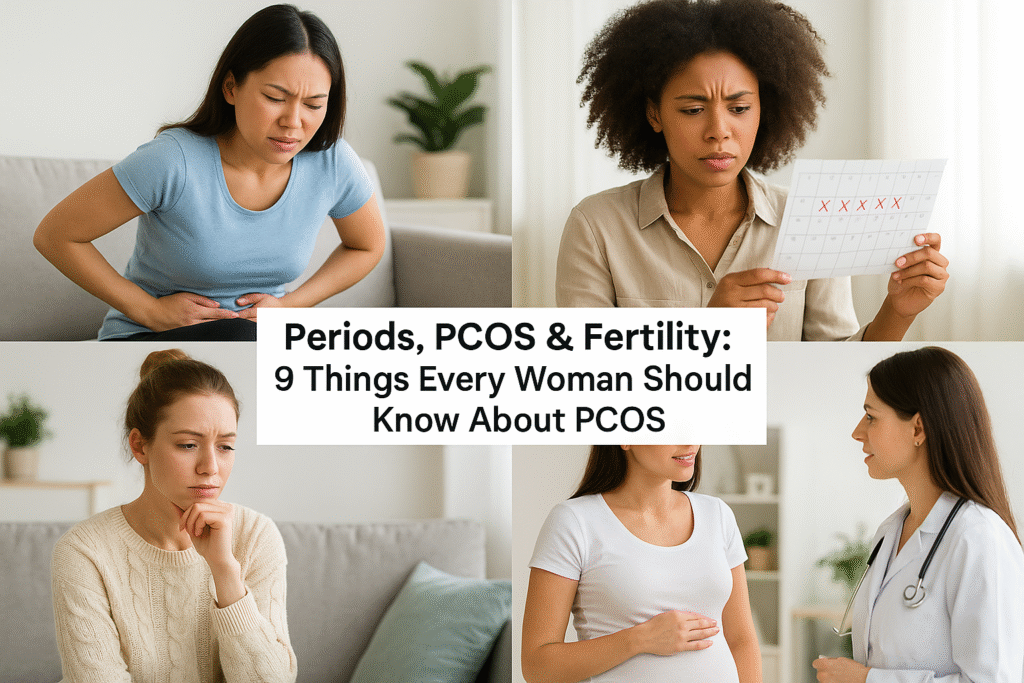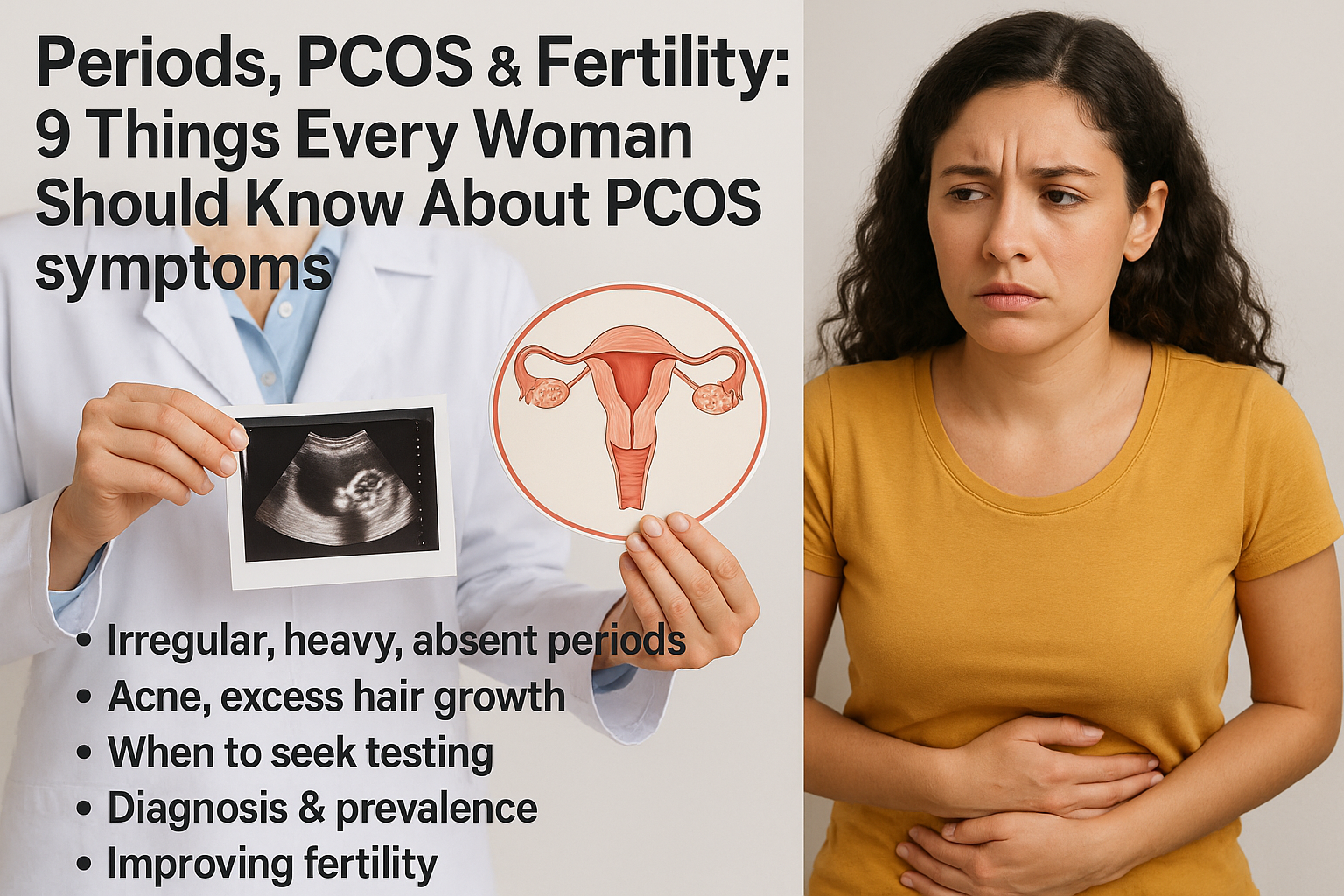PCOS symptoms: PCOS (polycystic ovary syndrome), menstrual disorders (irregular, heavy, absent periods), and fertility concerns are among the top reasons women seek medical care in their reproductive years. This guide explains common signs, when to seek testing, how doctors diagnose PCOS and menstrual problems, up-to-date prevalence and fertility figures, and simple—clinically supported—steps you can take now to improve symptoms and fertility prospects.
1) How common is PCOS, menstrual disorders and infertility?
- PCOS worldwide: Most recent global analyses put PCOS prevalence in reproductive-aged women roughly between 6% and 13%, depending on diagnostic criteria and region. Up to 70% of women with PCOS may be undiagnosed.
- Menstrual disorders: Estimates vary by condition and region. Reviews report irregular cycles in roughly 5%–35% of women (varies widely by age, occupation, and location), and heavy menstrual bleeding (HMB) prevalence commonly reported between ~10%–30% in many studies.
- Infertility in the U.S.: About 8.5% of married women ages 15–49 are infertile (varies by parity), and ~13%–16% have impaired fecundity depending on the measure used — fertility rates have been declining in recent years in the U.S. and many high-income countries.
Why this matters: PCOS is a leading cause of anovulation (missed ovulation) and fertility difficulty, and menstrual irregularities are often the first sign prompting evaluation. Early recognition shortens the time to effective treatment.
2) Common symptoms — how to spot a pattern
Look for clusters of the following (not every person will have all of them):
- Irregular periods (cycles longer than 35 days or fewer than 8 cycles/year) or missed periods.
- Heavy or prolonged bleeding (needing frequent pad/tampon changes, large clots, or flooding).
- Signs of hyperandrogenism: new/worsening acne, increased facial/body hair, male-pattern hair thinning.
- Weight gain, especially around the abdomen, or difficulty losing weight.
- Symptoms of insulin resistance (acanthosis nigricans — dark velvety skin on the neck/armpits), or a personal/family history of type 2 diabetes.
- Difficulty conceiving after 6–12 months of trying (or sooner if older than 35).
If you see a pattern, track it (see symptom log below) and talk to your clinician.
3) Why diagnosis can be delayed — and how long it takes
Symptoms often start in adolescence or early adulthood, but many people experience a delay from first symptoms to diagnosis. Research shows an average delay of around 4 years between symptom onset and receiving a PCOS diagnosis, often involving visits to more than one clinician. Keeping a clear symptom log shortens that delay and improves care conversations.
4) How clinicians diagnose PCOS & menstrual problems (simple checklist)
Diagnosis uses established criteria; in adults it’s generally based on at least two of these three:
- Irregular ovulation (oligo- or anovulation) or absent periods,
- Clinical or biochemical hyperandrogenism (signs/symptoms or lab elevations), and
- Polycystic ovarian morphology on ultrasound (though ultrasound alone is not diagnostic).
Your provider will usually order:
- A careful menstrual and medical history, BMI and blood pressure.
- Blood tests: pregnancy test (if applicable), FSH/LH, testosterone, TSH, prolactin, glucose/HbA1c or an OGTT if insulin resistance suspected, and lipids as needed.
- Pelvic ultrasound in some cases.
- Rule out other causes (thyroid disease, hyperprolactinemia, congenital adrenal hyperplasia, androgen-secreting tumours).
5) Fertility: what the data say by age (practical reality)
Age is the single strongest predictor of natural fertility. Authoritative reproductive bodies summarize the decline this way:
- Peak monthly chance of conception is in the 20s (roughly 20–25% chance per cycle) and declines slowly in the early 30s.
- By the mid- to late-30s it declines more quickly; by age 40, the chance of pregnancy per menstrual cycle is often <5%. Assisted reproduction success also falls with age.
If you’re trying for a baby and are older than 35 (or have PCOS and irregular cycles), consider earlier assessment since time-to-pregnancy can be longer and effective treatments are available.
6) Simple, evidence-backed “hacks” you can start today (lifestyle + tracking)
These are low-risk, high-benefit steps backed by clinical guidelines and trials:
1. Start tracking, consistently.
- Use the downloadable symptom log below. Note cycle day counts, flow, pain, mood, sleep, weight, medications, ovulation signs (OPK, cervical mucus, BBT). A clear 3-cycle record helps clinicians spot patterns quickly and reduces diagnostic delay.
2. Aim for modest weight loss if overweight.
- For many people with PCOS, 5–10% weight loss (if needed) often improves ovulation, menstrual regularity and metabolic markers — it’s the first-line, guideline-recommended approach. Even modest reductions in weight or waist circumference can make a tangible difference.
3. Move more (and in ways you enjoy).
- Aerobic and resistance exercise improves insulin sensitivity and can help normalize cycles. Set realistic activity goals (e.g., 150 minutes/week of moderate activity or a plan tailored with a clinician).
4. Try an evidence-based eating pattern — not a fad.
- Mediterranean-style diets, reduced-refined-carbohydrate approaches, or simply reducing processed sugar and increasing whole foods help with weight and insulin resistance in PCOS. Consistency beats extremes.
5. Mind the meds & supplements with an expert.
- Metformin (when indicated) improves insulin sensitivity; some supplements (e.g., myo-inositol) have evidence but discuss with your clinician before starting. Don’t start/stop prescription meds without medical advice.
6. Sleep, stress, mental health matter.
- Anxiety, depression and sleep disturbance are more common in PCOS; treating mental health improves adherence and outcomes. Ask your clinician for support or counseling referrals as needed.

7) Medical treatments for cycle regulation & fertility (what to expect)
(This is an overview — your clinician will choose therapies based on goals: symptom control vs trying to conceive.)
- For cycle regulation and acne/hirsutism: combined oral contraceptives are commonly used to regularize cycles and lower androgen effects; anti-androgen therapy (e.g., spironolactone) may be used in some cases (with contraception if pregnancy is possible).
- For fertility / ovulation induction: for anovulatory infertility in PCOS, letrozole (an aromatase inhibitor) is recommended as a first-line ovulation induction agent in many guidelines and has better live-birth rates than older drugs like clomiphene in several trials. If oral agents fail, options include injectable gonadotropins or IVF.
- Metformin may be used when insulin resistance is present (or for glucose regulation), sometimes alongside ovulation induction.
- Surgical options (e.g., ovarian drilling) or bariatric surgery (in selected, guideline-selected obese patients) are occasional options when other routes are unsuitable.
Always discuss risks, benefits and timing (especially if pregnancy is a near-term goal).
8) When to see a clinician — red flags & referral timing
See a healthcare provider if you have:
- Periods absent for 3 months (and not pregnant) or cycles consistently >35 days.
- Periods so heavy they limit daily activities (flooding, very frequent pad changes).
- New severe acne, sudden increased hair growth, or rapid weight gain.
- Tried for 12 months with regular unprotected sex without conception (or after 6 months if age ≥35, or earlier if you suspect a fertility problem).
Bring your symptom log — it makes visits faster, clearer and more actionable.
9) Realistic expectations & emotional support
PCOS is chronic for many people; there’s no single “cure,” but symptoms and fertility outcomes are highly manageable. Many people with PCOS conceive naturally or with targeted fertility treatment. Because PCOS often coexists with higher rates of anxiety/depression, seek emotional support or counseling as part of a treatment plan.
Symptom log template — download & how to use
I’ve created a clinician-friendly symptom log you can download, print, and bring to appointments:
How to use it:
- Fill one row per day during the cycle (or at least one entry every few days).
- Track for 2–3 cycles if possible (clinicians often ask for a 3-month overview).
- Note medication times/doses, OPK results, and questions for your clinician in the “Notes for doctor” column.
- If trying to conceive, mark ovulation signs and sexual activity to make timing clearer.
Sources & reading (selected authoritative references)
(Selected resources used to prepare this article — recent, reputable and government/peer-reviewed where possible.)
- WHO — Polycystic ovary syndrome fact sheet. (World Health Organization)
- Global systematic reviews/meta-analyses on PCOS prevalence. (PubMed)
- CDC — Infertility/Fecundity FastStats and U.S. fertility data briefs. (CDC)
- International & peer-reviewed guideline and review articles on PCOS diagnosis and management. (PMC, ASRM)
- Reviews and studies on menstrual disorder prevalence and heavy menstrual bleeding. (PMC, Frontiers)
Helpful government links (for further trusted reading)
(Placed here at the end as requested — these open directly)
- NHS (UK): Polycystic ovary syndrome (PCOS) — symptoms, diagnosis and treatment.
https://www.nhs.uk/conditions/polycystic-ovary-syndrome-pcos/ (nhs.uk) - U.S. Office on Women’s Health (HHS): Polycystic Ovary Syndrome — facts & patient info.
https://www.womenshealth.gov/a-z-topics/polycystic-ovary-syndrome (Office on Women’s Health)
Disclaimer
This article is for informational and educational purposes only and is not medical advice. It does not replace a consultation with a qualified healthcare professional. For diagnosis and personalized treatment options, please see a licensed clinician. Images used in this article are royalty‑free or licensed for commercial use and are provided here for illustrative purposes.
